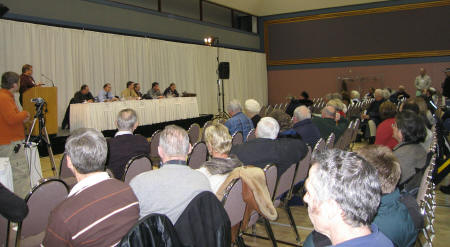Second Community Flood Forum Wraps Up

Attendees at tonight’s flood forum pose questions to the City’s EOC team members
Prince George, B.C.- Approximately 80 people turned out to a public meeting at the Civic Centre this evening for an update on the current situation with the Nechako icejam and the opportunity to pose questions to members of the City’s Emergency Operations Centre (EOC) and a rep from the Ministry of Environment.
Lyle Larsen, a flood hazard technician with the MoE, says the latest information he’s received is that the ice now spans 27-kilometres, with the head near the Bergman Road area of Miworth -- meaning it’s grown five-kilometres in a 24-hour period.
When asked what’s being done in light of this rapid expansion, Larsen says the raised gabion diking and earth berms that have been built up since the beginning of the month should be able to handle any future flooding in the Lower Nechako.
EOC member, Marco Fornari, gave the crowd an overview of the progress the Amphibex made during its eight days in operation. The unit’s work at opening a channel from the foot of the jam, combined with leads that opened up on their own, created an approximately seven-kilometre channel from fishtrap island down to the confluence with the Fraser. However, Fornari says, with the Fraser now frozen over, "there’s no where else to put ice right now." (As a result, the amphibious excavator was loaded on a truck bound for back east this afternoon.)
So, operations have shifted to maintaining the open water. Bob Radloff says for the past two weeks, warm well water from a City pump station near the Cameron Street Bridge has been entering the river. And, as of today, the warm water pipeline from Canfor’s Intercon Pulpmill is complete and pumping in water at approximately 14-degrees Celsius from the Canfor pumphouse near the Nechako’s confluence with the Fraser.
During the question-and-answer sesssion that followed, one woman asked why dredging wasn’t being done. Radloff says it takes a fair bit of scientific data to get government approval to allow that work. He says it’s a legitimate option, but one that must be done properly. Radloff notes dredging will be explored as part of a study the City hopes to undertake with the province to look at long-term flood solutions.
Several others in attendance were upset with the study’s timeframe of approximately 14-months, saying they don’t want to be faced with the same flood threat next winter. Radloff says the temporary works that have been done this year will remain in place, but he says there is a way to reduce the timeframe, and that’s to reduce the scope of work. "But what we’re hearing from the community, is they want to really thoroughly look at all the long-term options, so to do it justice and give the community a solution that is going to help them not just next year -- we’re talking 50 or 100 years -- a permanent solution takes that kind of time to analyze it."
Previous Story - Next Story
Return to Home









